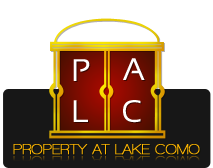Palazzo Terragni, formerly known as Casa del Fascio (House of Fascism) in Como, is located in Piazza del Popolo 4 square and is one of the most interesting Italian rationalist buildings.
Designed by Giuseppe Terragni in 1932, after a failed attempt in 1930 to purchase the headquarters of the Credito Italiano bank to house the Casa del Fascio (the earliest designs actually date back to 1928), he received the commission from the federal secretary Egidio Proserpio to fulfil "the desire of all Fascists in the city and the province” in the present-day Piazza del Popolo, opposite the majestic Cathedral of Como. However, due to various problems, the previously established building area was insufficient and suffered from water infiltration. The construction work, which wasn’t begun until July 1933, ended in 1936.
An enormous building with a square layout gradually took shape: almost seventeen metres in height and width, lightened by a symmetrical play of full and empty volumes, of glass and reinforced concrete pillars, along with the innovative use of alloys and bottoncino marble.
Terragni designed a crisp, airy building. A candid and compact prism with rectangular openings gives lightness and brightness to the entire architectural structure.
Four years would pass before the building was finally completed.
Terragni designed and supervised every minor detail, including the furnishings, which the painter Mario Radice was also involved in creating, with a series of abstract frescoes that were unfortunately destroyed during the Liberation.
The building is shaped like a large parallelepiped formed by surfaces of pure geometry: on a side of 33.2 metres, for a height reduced by half, are both full and empty volumes that create a basic yet efficient effect, of striking plays of light and dark and transparencies. The materials are arranged into shapes to create parallel lines and right angles, making the architectural ensemble harmonious. The interior is also created with Trani marble and black Belgian marble, as well as painted plaster.
Palazzo Terragni is positioned three steps higher than the roadway to create a monumental effect, and interacts with nearby elements: the mountain of Brunate, the Social Theatre and the Cathedral. Passing through one of the eighteen glass door you reach an atrium which overlooks the main room: the Directorate’s quarters, offices and balconies.
The atrium is covered by curtains of glass blocks, along which a long sheet of glass is positioned offering glimpses of the hill above.
Originally, the interior and exterior were decorated by coloured cement panels depicting abstracted subjects, propaganda images and empty spaces mounted on glass frames, works by Mario Radice and Manlio Rho that are no longer in existence today.
Since 1957 it has served as the provincial headquarters of Como's Guardia di Finanza police force. It currently houses the small Museum of the 6th Legion of the Guardia di Finanza.
The majority of the buildings designed by Terragni in Como can be found near the public gardens along the lake, close to the stadium. The city is rich with historic and prestigious buildings, some of which are available for sale or rent.
NOVOCOMUM
The first building constructed by Giuseppe Terragni, the Novocomum residence dating back to 1927-29, which for its unusual shape suggested the ironic name "transatlantic", is the first example of Italian rationalist architecture.
It was created to complete a large, eclectic style apartment building constructed in the mid-1920’s.
Previously destined for demolition, Novocomum was saved by a ruling of a special commission instituted by the city.
The large building is characterised for the relationship between the long facade marked by the horizontal openings of the windows and balconies, plastically carved below by a glass cylinder. The rather vivid original colours of the building’s exterior were lost, yet are still visible inside courtyard.
Consisting of five floors and an attic, for a total of 200 units harmoniously distributed with perfectly linear forms, which make no concessions to decoration or rhetoric, the building is made up by simple lines, pure surfaces of walls and glass articulated and rhythmically modulated by the light.





